Hello! While I was cleaning my garage I found a pair of Ciare PA065 which I bought a long time ago. I never used those drivers and I would like to make a pair of good speakers for my room. So far I've had some ideas, I have some doubts about the pros and cons of each solution.
Idea 1)
These seem like the perfect kind of drivers to use for a FAST, but I don't have any other driver to complement it. I could get a pair of TB W46-1316SM (yes they're 4"x6") woofers which are cheap here, small and with plenty of Xmax. Really the only downside should be the cost, which would consist in a pair of woofers and a passive crossover network.
Would be fun to design a waveguide for it, but I've never done such thing and I don't know if there is any commercial waveguide that fits that size of speaker.
Or, I could experiment and use the Ciare as a dipole tweeter.
Could also still try to add the magnet on the back in order to gain a bit of SPL.
Idea 2)
A quick glance at the parameters shows a very high Qts mated with a high Fs (154Hz) and low Xmax (1mm). This makes the speaker not very good in a sealed box because of a very reduced bass extension and power handling, and terrible in bass reflex because of a crazy high Qts. I could glue a magnet on the back of the speaker but I doubt I could get the Qts under ~0,8. But what if I purposedly built a strongly resonant BR enclosure and then EQd it down using a first order high pass? I would get both the high efficency of the BR and I could really limit the excursion thanks to the HP filter. The box would be quite big especially for such a small speaker, but how could it sound?
I won't be able to use a passive HP, so I would probably have to make the speakers active and make an active HP using opamps. I could use a TDA7292 board which are really cheap. I don't think I will be able to use a PLLXO unless I stick to a known source, like a bluetooth receiver. I could adjust BSC by playing with the HP frequency.
This is in a 10 liters enclosure, tuned to 100Hz and highpassed with a 1st order @ 300Hz
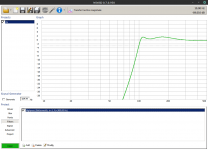
This is with without any filters whatsover. There are over 10dB of ripple at Fb.
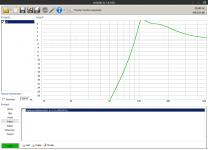
Idea 3)
Just make a 2.1 with it. Satellites could be either OB or sealed. That would be a very boring approach which I've seen too many times.
Idea 1)
These seem like the perfect kind of drivers to use for a FAST, but I don't have any other driver to complement it. I could get a pair of TB W46-1316SM (yes they're 4"x6") woofers which are cheap here, small and with plenty of Xmax. Really the only downside should be the cost, which would consist in a pair of woofers and a passive crossover network.
Would be fun to design a waveguide for it, but I've never done such thing and I don't know if there is any commercial waveguide that fits that size of speaker.
Or, I could experiment and use the Ciare as a dipole tweeter.
Could also still try to add the magnet on the back in order to gain a bit of SPL.
Idea 2)
A quick glance at the parameters shows a very high Qts mated with a high Fs (154Hz) and low Xmax (1mm). This makes the speaker not very good in a sealed box because of a very reduced bass extension and power handling, and terrible in bass reflex because of a crazy high Qts. I could glue a magnet on the back of the speaker but I doubt I could get the Qts under ~0,8. But what if I purposedly built a strongly resonant BR enclosure and then EQd it down using a first order high pass? I would get both the high efficency of the BR and I could really limit the excursion thanks to the HP filter. The box would be quite big especially for such a small speaker, but how could it sound?
I won't be able to use a passive HP, so I would probably have to make the speakers active and make an active HP using opamps. I could use a TDA7292 board which are really cheap. I don't think I will be able to use a PLLXO unless I stick to a known source, like a bluetooth receiver. I could adjust BSC by playing with the HP frequency.
This is in a 10 liters enclosure, tuned to 100Hz and highpassed with a 1st order @ 300Hz

This is with without any filters whatsover. There are over 10dB of ripple at Fb.

Idea 3)
Just make a 2.1 with it. Satellites could be either OB or sealed. That would be a very boring approach which I've seen too many times.
Historically for high Qt drivers I've always either stuffed a vented box or more often after I learned TL theory made a stuffed TL or TQWT, i.e. a ~aperiodic alignment.
In HR a 6.5 cm x 3 cm i.d. pipe = 19.5 cm^2 i.d. x 111 cm long (TL) with driver offset at 39 cm yields a flat response to 200 Hz/~83 dB/W/m once stuffed to 'taste' 😉 and a 30 W power limit at 400 Hz/2nd order hi-pass.
In HR a 6.5 cm x 3 cm i.d. pipe = 19.5 cm^2 i.d. x 111 cm long (TL) with driver offset at 39 cm yields a flat response to 200 Hz/~83 dB/W/m once stuffed to 'taste' 😉 and a 30 W power limit at 400 Hz/2nd order hi-pass.
Attachments
Thank you. I've opened the file on Hornresp, apparently it didn't save the stuffing for it. I've played around with it a bit and around 35% filling for the "upper" part and 40% for the lower part seems yelds a decent response. But, besides the much smaller size, what would be the advantage of a similiar solution instead of the assisted bass reflex enclosure I designed if I want to use it full-range?
The GD seems lower in the TL peaking at about 3,8ms at 160Hz instead of almost 20ms at 100Hz, but even that shouldn't be too problematic.
And if I want to high-pass it at 400Hz, why should I make a TL and not a much simpler IB/OB?
Do you think a lower Qts could help?
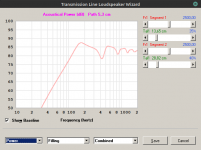
The GD seems lower in the TL peaking at about 3,8ms at 160Hz instead of almost 20ms at 100Hz, but even that shouldn't be too problematic.
And if I want to high-pass it at 400Hz, why should I make a TL and not a much simpler IB/OB?
Do you think a lower Qts could help?

Thank you. I've opened the file on Hornresp, apparently it didn't save the stuffing for it. I've played around with it a bit and around 35% filling for the "upper" part and 40% for the lower part seems yelds a decent response. But, besides the much smaller size, what would be the advantage of a similiar solution instead of the assisted bass reflex enclosure I designed if I want to use it full-range?
The GD seems lower in the TL peaking at about 3,8ms at 160Hz instead of almost 20ms at 100Hz, but even that shouldn't be too problematic.
And if I want to high-pass it at 400Hz, why should I make a TL and not a much simpler IB/OB?
Do you think a lower Qts could help?
View attachment 1091486
Hmm, it shows the filling when I just now imported it, so no clue why it's missing for you. It shows '2500' @ 100% for both segments, which plots ~2.1 ms @ Fs.
Stuffed vented, TLs are an acoustic solution to an acoustic problem back when power was at a premium and passive EQ sapped away efficiency and now DSP allows one to stick a driver in 'whatever' box size/type and digitally frequency shape it without penalty.
You indicated wanting something not 'boring', hence posted the pioneer's many decades proven high SQ suggestion rather than critiquing your designs.
Re OB, IB for bass are in theory the best option if the baffle is large enough with the stuffed TL being a tiny version of an IB, so yes, from this perspective it's a 'packaging' choice.
Performance wise I prefer ~aperiodic, but you'll have to do your own comparisons as to which is superior overall to other options for your app.
I suspect that Windows is not being used, in which case anything can happen... 🙂.Hmm, it shows the filling when I just now imported it, so no clue why it's missing for you.
Yes I am on Linux, Hornresp is running through Wine!
Thank you for your considerations. Never looked at it that way, stuffed TL would make a compact speaker with decent power handling, compared to all the other options. I will try to measure the exact parameters of the drivers, and I'll also measure them with an added magnet in the back.
Thank you for your considerations. Never looked at it that way, stuffed TL would make a compact speaker with decent power handling, compared to all the other options. I will try to measure the exact parameters of the drivers, and I'll also measure them with an added magnet in the back.
I've added the magnets that I "stole" from some very old (and very broken) Ask speakers I got from a Fiat in a junkyard. It was just the right size, about 4mm bigger than the magnet already present on the speaker.
The Qts dropped plenty to a more manageable 0.84 and all the other parameters improved as well! Here's the spreadsheet with the data from the two speakers, and the average between the two. I'm also attaching a "before".
PA065 added magnet tsp
The Qts dropped plenty to a more manageable 0.84 and all the other parameters improved as well! Here's the spreadsheet with the data from the two speakers, and the average between the two. I'm also attaching a "before".
PA065 added magnet tsp
Attachments
This is a quick simulation I made in WinIsd with the data I have. The box is MUCH smaller and doesn't require an active filter! Qa=20 so it should be a stuffed bass reflex box! It also seems to go very low!
The maximum SPL also looks kind of decent for a cone so small... but I'm not too sure for the 150Hz region. I have to say that Ciare tends to be a little pessimistic about his Xmax rating so maybe it'll play louder without too much struggle.
I've noticed that if I tick the "use "transmission line" model for port simulation" in WinISD the graphs improve, why is that?
Hmm, can't quickly find my notes on stuffing, so no clue ATM re Qa, but as damping increases, QL decreases with '1' being maximally stuffed.
Good question since a vent is a TL, so guessing it means vent damping or what the pioneers call 'critically' damping the system: Click Test:
Good question since a vent is a TL, so guessing it means vent damping or what the pioneers call 'critically' damping the system: Click Test:
Qa (absorption) should indicated how stuffed the box is in WinISD. 100 is an empty while 1 is full
Ql (leakage) is how leaky the box is. I think 10 is a realistic value.
Qp (port) represents port losses.
I've started playing around on Hornresp, I still don't have much of a clue on how to design more complex horns but this TL seemed pretty straightforward and it's more interesting to me compared to a regular ported BR. The FR graph looks very promising, but I don't know how to "read behind" the graph with TLs. Is what I see going to work or did I make some major mistakes? Are the "upper" resonances going to ruin the sound?

Ql (leakage) is how leaky the box is. I think 10 is a realistic value.
Qp (port) represents port losses.
This is very useful, if it works! It's a great way to tune the system even without IR.Hmm, can't quickly find my notes on stuffing, so no clue ATM re Qa, but as damping increases, QL decreases with '1' being maximally stuffed.
Good question since a vent is a TL, so guessing it means vent damping or what the pioneers call 'critically' damping the system: Click Test:
I've started playing around on Hornresp, I still don't have much of a clue on how to design more complex horns but this TL seemed pretty straightforward and it's more interesting to me compared to a regular ported BR. The FR graph looks very promising, but I don't know how to "read behind" the graph with TLs. Is what I see going to work or did I make some major mistakes? Are the "upper" resonances going to ruin the sound?
Attachments
I've finished the speakers!
I've decided to make a 2,6L reflex box tuned to 100Hz (later measured 98Hz) because I had some cheapo speaker of that size I could salvage the cabinet from. It was made of 6mm MDF. I braced it with a single piece of 2x4 and it became very solid and sturdy.
I had to mount the speakers on the inside on the inside of the baffle because they had a very narrow flange which made getting a good seal impossible.
I used 4mm MDF for the front to avoid horn loading the speaker. Sealed the speaker edge with blutack and then screwed the front panel to the cabinet.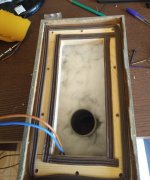

This is how they look on the final setup! They're being powered by a very small and very cheap TDA7297 board visible on the left of my pc. They do sound very nice. The soundstage is excellent and the sound is spectacular.
Without eq they're a bit shouty at 2,5kHz, but the mid bass is there, at least until 80Hz. There seems to be a bit of "boom" in my current room at around 135Hz which I had to eq down by about 4dB. If I move them to another room they're fine. I also added a 4th order butterworth high pass filter at 60Hz to protect the speaker from over excursion.
I think leveling the edges might help for the "shouty-ness", but I will have to bring the speakers to a woodworker for that.
They sound quite punchy even if not very full, obviously. They get decently loud and somehow still manage to fill my room.
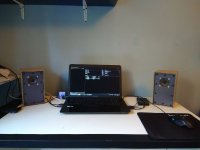
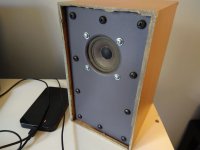
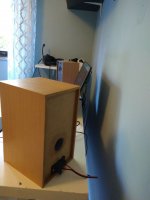
I had some measurements but I forgot to save those so I need to take them again... ooops!
I've decided to make a 2,6L reflex box tuned to 100Hz (later measured 98Hz) because I had some cheapo speaker of that size I could salvage the cabinet from. It was made of 6mm MDF. I braced it with a single piece of 2x4 and it became very solid and sturdy.
I had to mount the speakers on the inside on the inside of the baffle because they had a very narrow flange which made getting a good seal impossible.
I used 4mm MDF for the front to avoid horn loading the speaker. Sealed the speaker edge with blutack and then screwed the front panel to the cabinet.


This is how they look on the final setup! They're being powered by a very small and very cheap TDA7297 board visible on the left of my pc. They do sound very nice. The soundstage is excellent and the sound is spectacular.
Without eq they're a bit shouty at 2,5kHz, but the mid bass is there, at least until 80Hz. There seems to be a bit of "boom" in my current room at around 135Hz which I had to eq down by about 4dB. If I move them to another room they're fine. I also added a 4th order butterworth high pass filter at 60Hz to protect the speaker from over excursion.
I think leveling the edges might help for the "shouty-ness", but I will have to bring the speakers to a woodworker for that.
They sound quite punchy even if not very full, obviously. They get decently loud and somehow still manage to fill my room.



I had some measurements but I forgot to save those so I need to take them again... ooops!
- Home
- Loudspeakers
- Full Range
- What can I do with a one way 2,5" Ciare driver? High QTS/low xmax